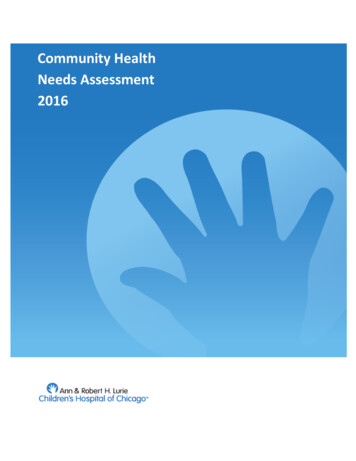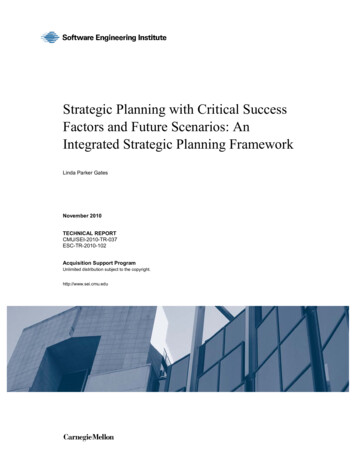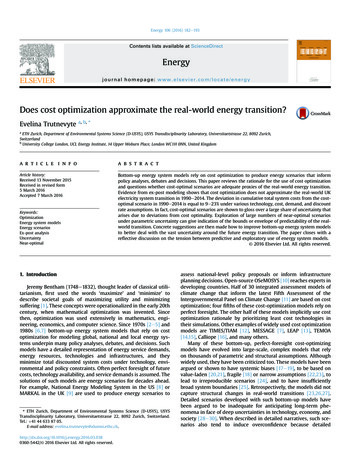
Transcription
2016Pediatric Disaster TriageTraining Scenarios:Utilizing the JumpSTART Method
Pediatric Disaster Triage Training Scenarios: Utilizing the JumpSTART Method2016Table of ContentsACKNOWLEDGEMENTS . 2HOW TO USE THIS DOCUMENT . 3START: SIMPLE TRIAGE AND RAPID TREATMENT . 4START TRIAGE ALGORITHM . 5JUMPSTART : PEDIATRIC MASS CASUALTY INCIDENT (MCI) TRIAGE TOOL . 6JUMPSTART TRIAGE ALGORITHM . 8SCENARIOS . 9SCENARIO 1 . 9SCENARIO 2 . 12SCENARIO 3 . 13SCENARIO 4 . 16SCENARIO 5 . 16SCENARIO 6 . 16RESOURCES: . 181
Pediatric Disaster Triage Training Scenarios: Utilizing the JumpSTART Method2016AcknowledgementsIllinois Emergency Medical Services for Children (EMSC) gratefully acknowledges the commitment anddedication of all who contributed to the development of this document. Illinois EMSC is a collaborativeprogram between the Illinois Department of Public Health and Ann & Robert H. Lurie Children's Hospitalof Chicago. This document was developed by Illinois EMSC under the direction of the PediatricPreparedness Workgroup that dually reports to the EMSC Advisory Board and the Illinois Terrorism TaskForce.The development, initial printing and distribution of this booklet was supported through federal fundingfrom the Assistant Secretary for Preparedness and Response (ASPR).2
Pediatric Disaster Triage Training Scenarios: Utilizing the JumpSTART Method2016How to Use This DocumentThis document is offered as a resource to organizations as they conduct drills and exercises that involve masscasualty incident (MCI) triage and the use of START and JumpSTART Triage methods. Inclusion of infants andchildren in disaster drills and exercises is an essential component in preparedness efforts, and can assist inpreparing an organization to treat critically ill or injured pediatric patients during an actual disaster or masscasualty incident (MCI).Please note that any recommendations in this document are based on current information and guidelines foundwithin the medical literature at the time of publication.NOTE: This document defines the pediatric age range as 15 years of age and younger in accordancewith the Emergency Medical Services and Trauma Center Code adopted by the Illinois Department ofPublic Health. Exceptions may include the population of children with special healthcare needs/children with functional access needs.3
Pediatric Disaster Triage Training Scenarios: Utilizing the JumpSTART Method2016START: Simple Triage and Rapid TreatmentDisaster triage is a method of quickly identifying victims who have life-threatening injuries and who also have thebest chance of survival. Identification of such victims serves to direct other rescuers and health care providersto these patients first when they arrive on the scene.One of the most widely recognized mass casualty incident (MCI) triage systems in the United States is theSTART Triage System (Simple Triage and Rapid Treatment). This system uses the assessment of respiration,perfusion and mental status (RPM) to make a primary triage decision in less than 30 seconds. The STARTTriage System is one method of triage which can be used in a MCI, and it was developed by Hoag Hospital andthe Newport Beach Fire Department of Newport Beach, Calif. It was designed to allow first responders to triageor assess multiple victims rapidly, usually taking less than a minute, to determine which category each shouldbe assigned. The assessment and triage is based on three primary observations: Respiratory, Perfusion, andMental Status (RPM).The four triage categories are: IMMEDIATE, DELAYED, MINOR, and EXPECTANT/DECEASED.The START Triage System is intended for adults, but may also be used for older children. Determining theappropriate system to use in the pre-adolescent and young teen population can be sometimes challenging, sothe current recommendation is: If a victim appears to be a child, use JumpSTART ; If a victim appears to be ayoung adult, use START.The triage steps of the START Triage System are as follows: Step 1: All victims who are able to walk are directed to an area designated for minor injuries wherethey will undergo a secondary and more involved triage and assessment. Any non-ambulatory victimreporting to this area, such as a wheelchair bound victim or infants carried to the area, must undergo athorough evaluation upon arrival to ascertain the correct triage status. Step 2:a) All remaining non-ambulatory victims are now assessed for the presence of spontaneousbreathing (respirations). If spontaneous breathing is absent and not restored throughconventional positional techniques to open the airway, the victim is tagged EXPECTANT/DECEASED and the triage officer moves on to the next victim. If breathing is restored withrepositioning, the victim is tagged IMMEDIATE and the triage officer moves on.b) If spontaneous breathing is present, the rate is assessed: a rate above 30/minute receives aIMMEDIATE and the triage officer moves on; if the rate is less than 30, the triage officer moveson to step 3. Step 3: The victim is now assessed for perfusion. This can be done by either capillary refill or radialpulse. If the radial pulse is absent or the capillary refill is 2 seconds the victim is tagged IMMEDIATE.If a radial pulse is present or capillary refill is 2 seconds, the triage officer proceeds to the next step. Step 4: The triage officer now checks the mental status of the victim. If the victim cannot follow simplecommands, is unconscious, or has altered state of consciousness, he/she receives an IMMEDIATEtag for immediate treatment. If the victim can follow simple commands, he/she receives a DELAYEDtag for delayed treatment.NOTE: For all IMMEDIATE victims, the triage officer must also attempt to control bleeding before moving on tothe next patient. All victims tagged EXPECTANT/DECEASED, unless clearly suffering from injuriesincompatible with life, should be reassessed once critical interventions for IMMEDIATE and DELAYED victimsare completed.For more information please visit www.start-triage.com4
Pediatric Disaster Triage Training Scenarios: Utilizing the JumpSTART MethodSTART TRIAGE ALGORITHM52016
Pediatric Disaster Triage Training Scenarios: Utilizing the JumpSTART Method2016JumpSTART : Pediatric Mass Casualty Incident (MCI)Triage ToolWhen triaging children, a standardized disaster triage system provides guidance for personnel making life anddeath decisions that otherwise may be influenced by emotional issues.JumpSTART Pediatric Mass Casualty Incident (MCI) Triage Tool is an objective triage system that addressesthe needs of children and can be a resource tool when planning a triage process for pediatric patients. Althoughthe JumpSTART system parallels the START system, it takes into consideration the developmental andphysiological differences of children by using breathing as the cornerstone for triage decisions. Adding arespiratory component to the triage system may increase triage time by 15-25 seconds, however, since thenumber of patients requiring a ventilatory trial would most likely be small, it is not thought to significantly affectoverall triage time for an incident.Additionally, since the physiologic indicators specified for START are not generally applicable to the pediatricvictim, different criteria are needed to assess young patients. For example, neurological status under STARTdepends on the patient’s ability to obey commands. This index is clearly not applicable to young children wholack the developmental ability to respond appropriately to commands.The JumpSTART Pediatric MCI triage system is designed for triaging infants and young children.Determining the appropriate system to use in the pre-adolescent and young teen population can be sometimeschallenging, so the current recommendation is: If a victim appears to be a child, use JumpSTART; if a victimappears to be a young adult, use START.JumpSTART uses the same triage categories as START: IMMEDIATE, DELAYED, MINOR, andEXPECTANT/ DECEASED.In children, because of anatomical/physiological reasons such as weak intercostal muscles or mechanicalairway obstruction, apnea may occur rapidly. Thus circulatory failure usually follows respiratory failure.There may be a period of time when the child is apneic but continues to maintain a pulse. It is during this timethat airway clearance and a ventilatory trial may stimulate spontaneous breathing. If spontaneous breathingbegins, the child is categorized as IMMEDIATE for further treatment. If spontaneous breathing does not followthe initial ventilatory trial, the child is categorized as EXPECTANT/DECEASED or non-salvageable.The triage steps of the JumpSTART Pediatric MCI triage system are as follows: Step 1: All children who are able to walk are directed to an area designated for minor injuries wherethey will undergo a secondary and more involved triage. Infants carried to this area or other nonambulatory children taken to this area must undergo a complete medical and primary evaluation usingmodifications for non-ambulatory children to ascertain triage status. (Please refer to the Modificationsfor Non-Ambulatory Children* section on the following page). Step 2:a) All remaining non-ambulatory children are assessed for the presence/absence of spontaneousbreathing. If spontaneous breathing is present, the rate is assessed and the triage officermoves on to step three.b) If spontaneous breathing is not present and is not triggered by conventional positionaltechniques to open the airway, palpate for a pulse (peripheral preferred). If no pulse ispresent, patient is tagged DECEASED/EXPECTANT and the triage officer moves on.6
Pediatric Disaster Triage Training Scenarios: Utilizing the JumpSTART Method2016c) If there is a palpable pulse, the rescuer gives five breaths (approximately 15 sec.) using mouthto mask barrier technique. If the ventilatory trial fails to trigger spontaneous respirations, thepatient is tagged EXPECTANT/DECEASED and the triage officer moves on. However, ifrespirations resume, the patient is tagged IMMEDIATE and the triage officer moves onwithout providing any further ventilations. Step 3: If the respiratory rate is 15-45/minute, proceed to checking perfusion. If the respiratory rate isless than 15 (less than 1/every 4 seconds) or faster than 45/minute or irregular, tag as IMMEDIATEand move on. Step 4: Assess perfusion by palpating pulses on a (seemingly) uninjured limb. If pulses are palpable,proceed to Step 5. If there are no palpable pulses, the patient is tagged IMMEDIATE and the triageofficer moves on. Step 5: At this point all patients have “adequate” ABCs. The triage officer performs a rapid AVPUassessment of mental status. If the patient is Alert, responds to Voice, or responds appropriately toPain (withdraws from stimulus or pushes away), the patient is tagged DELAYED and the triage officermoves on. If the patient does not respond to voice and responds inappropriately to pain (moans ormoves in a non-localizing fashion) or is Unresponsive, an IMMEDIATE tag is applied and the triageofficer moves on to the next patient.NOTE: All patients tagged EXPECTANT/DECEASED, unless clearly suffering from injuries incompatible withlife, should be reassessed once critical interventions for IMMEDIATE and DELAYED victims are completed.*Modifications for Non-Ambulatory ChildrenChildren in which this modification would be used include: Infants who normally can’t walk yet Children with developmental delay Children with acute injuries which prevented them from walking before the incident occurred Children with chronic disabilitiesNon-ambulatory children who meet the above criteria are evaluated using the JumpSTART algorithmbeginning with Step 2. If the child meets any IMMEDIATE criteria, the child is tagged IMMEDIATE. A quicksurvey is then conducted to determine whether there are any significant external signs of injury (i.e. deeppenetrating wounds, severe bleeding, severe burns, amputations, distended tender abdomen or multiplebruises). If any significant external signs of injury are present, the child is tagged DELAYED. Non-ambulatorychildren without any significant external injury, with all other aspects of the JumpSTART algorithm normal, aretagged MINOR.NOTE: Final disposition (transport destination) depends on local and regional resources.Drills and table top exercises should include discussion about transport based on the actualresources available to the participants.This information was obtained from the JumpSTART Pediatric MCI Triage Tool website. The JumpSTART pediatric MCI field triage tool was developed by Lou Romig, M.D. Pediatric Emergency Medicine at MiamiChildren’s Hospital in Miami, FL in 1995 and modified in 2002. For additional information visitwww.jumpstarttriage.com.7
Pediatric Disaster Triage Training Scenarios: Utilizing the JumpSTART MethodJumpSTART TRIAGE ALGORITHM82016
Pediatric Disaster Triage Training Scenarios: Utilizing the JumpSTART Method2016ScenariosSCENARIO 18:15 a.m. A call to 911 is received. As 5th grade students were arriving by bus this morning to XYZ MiddleSchool for a science lab field trip, several children noted an unusually large pipe on the lawn outside aclassroom window near the back parking lot. The assistant principal, who phoned in the concern, offered tomeet police outside the front of the school near the main office in about five minutes. There were two sick callswith office staff today, including the principal. Until substitute teachers arrive, the assistant principal is busy withmorning announcements.As the first police unit arrives, an explosion occurs near the back of the school, taking down the outside wall andwindows of at least one classroom. The responding officer calls dispatch to report the event and requestsadditional personnel and EMS at the scene.This middle school houses more than 500 individuals including students and staff. As the smoke outsideclears, it is evident that at least one affected room is the science lab where the visiting 5th graders, a teacher andstudent teacher were present. The adjacent rooms are another science lab and the lab supplies storage room.Across the hallway in this wing of the school are the nurse’s office and the furnace/utility room.The first few victims are able to move/stumble out of the wreckage. They are coughing with eyes tearing,complaining of chest tightness, stomach cramping, and runny noses. On exam they all have constricted pupils.The assistant principal, visibly shaken, mumbles something about the science teacher being recently separatedfrom her husband, and that she had recently been able to secure an order of protection from him. Apparentlyhe had retired from his post as an explosives expert in a branch of the military reserves. He also had beenemployed by the school district but was on leave pending a psychiatric assessment after threats he had madeto his wife.STOP: At this point, please identify and list important considerations for this component of the scenario,including the possible exposure to a nerve agent or choking agent. In addition, this scenario can be adapted atthis point depending on the training participants’ ’ disciplines. For example, if the training participants are prehospital providers, the scenario can be tailored to their role in responding to the scene or if the trainingparticipants are hospital based providers, the scenario can be followed as written.Additional rescue units arrive on the scene. Neighbors and parents who have heard the sirens start to gatheroutside the school and are becoming panicked and hysterical. The first television news crews arrive and severalmorning traffic helicopters are heard overhead.A fire erupts in the science storage lab where liquid chemicals had spilled and poured onto the floor. The firequickly spreads across to the nurse’s room where the parent information forms are stored. The nurse is foundunconscious with head injuries. More victims are located in the science labs and hallway. Smoke is filling theschool hallways.8:45 am. You are the charge nurse of a local ED located a couple of blocks from the school affected by thisincident and have been notified to expect victims. Your waiting room is already filled with patients waiting to beseen. You and the ED physician begin to discuss how to respond.9 a.m. While you’re trying to put in place all the pieces to handle the expectant arrival of victims from the school,several parents of children who attend XYZ School show up in your ED inquiring about their children. At thesame time several children from the affected school and several teachers walk into your emergency department.STOP: At this point, what would you do next? Please identify and list important considerations for thiscomponent of the scenario9
Pediatric Disaster Triage Training Scenarios: Utilizing the JumpSTART Method2016Using the appropriate triage algorithm, categorize each of the following victims and provide justification forselecting that category.SCENARIO 1 VICTIM LISTVICTIMRESPIRATORYRATEPERFUSIONMENTAL STATUSOTHERTeen MRR 38Radial pulse presentKnows name and can recallincidentFacial burns, coughing, pupils constrictedChild FRR 32Palpable pulseAlert, crying hystericallyMultiple small lacs with embedded wood and glass entiredorsal area of body, head to footChild MRR 12Weak, thready pulseDisoriented to place and timeHematoma forehead, facial lacerationsAdult MRR 48Capillary refill 2Moaning, unable to followcommandsLarge glass chard protruding from abdomen, wheezingTeen FRR 8Pulse absentUnresponsiveImpaled onto shelving brackets on wallChild MRR 36Pulse presentWon't speak but makes eyecontact with touchBleeding from ears, bruise on neckChild FRR 0Weak radial pulseUnresponsiveTrapped under rubble; apneic after 5 rescue breathsChild FRR 52Thready pulseConfusedCoughing, brisk bleeding from facial and hand lacerationsTeen MRR 40Pulse presentDisoriented to place and timeScalp lacerations, burns to upper extremitiesChild MRR 10Weak rapid pulseUnresponsiveBunsen burner imbedded in upper arm - heavy bleedingChild MRR 40Pulse presentResponds appropriately topainful stimuliOpen femur fracture, lacerations to hands and faceTeen FRR 48Pulse rapid and weakResponds only to touchDeformity right upper extremity, glass shrapnel in scalpChild FRR 32Pulse presentCrying but oriented x 3Open fracture lower leg; contusions to arms and chestChild MRR 36Bounding pulseAlert but won't speakBurns to neck and torso, lacerations to armsTeen FRR 44Pulse weakHystericalPartial amputation right forearmAdult FRR 28Capillary refill 2Crying for help, able to recalleventsLeg caught under lab desk and chairs - open fractureTeen MRR 10Pulse present - slowUnresponsiveNo obvious injuriesTeen FRRUnable to countRapid pulseCrying hysterically, will notanswer questionsGrabbing rescuersChild MRR 24Pulse presentAlertVomiting, drooling, incontinentChild FRR 0Absent pulseUnresponsiveTrapped under rubbleChild MRR 32Rapid pulseAlert and anxiousCoughing, vomiting, incontinent, tearing, runny noseChild FRR28Rapid pulseAlertCrying, no obvious injuriesChild MRR 34Rapid pulseKeeps asking same questionsTearing, runny nose, incontinentChild FRR 30Rapid thready pulseSleepy - difficult to arouseDiaphoreticChild FRR 28Pulse presentAlertCan currently speak, facial, neck and upper extremityburnsChild MRR 50Pulse presentConfusedWheezing, facial and torso burnsChild FRR 44Radial pulse weakResponds to verbal stimuli,disorientedLarge bruise forming on abdomen, burns on legsScenario 1 Instructor ResourceOn the following page, the correct triage category designation is listed for each of the sample victims based on theinformation provided. START is used for teen and adult victims. JumpSTART is used for infants and children. Yourdisaster drill may incorporate additional information on each victim which may result in a different triage assignment. Inaddition, the availability of resources, such as an antidote to the nerve agent simulated in this scenario, may also result in adifferent triage assignment.10
Pediatric Disaster Triage Training Scenarios: Utilizing the JumpSTART Method2016.Scenario #1: Victim List with Triage Category DesignationVICTIMRESPIRATORYRATEPERFUSIONMENTAL STATUSOTHERTRIAGECATEGORYTeen MRR 38Radial pulsepresentKnows name and canrecall incidentFacial burns, coughing, pupils constrictedChild FRR 32Palpable pulseAlert, cryingMultiple small lacs with embedded wood andglass entire dorsal area of body, head to footChild MRR 12Weak, threadypulseDisoriented to place andtimeHematoma forehead, facial lacerationsAdult MRR 48Capillary refill 2Moaning, unable to followcommandsLarge glass chard protruding from abdomen,wheezingIMMEDIATETeen FRR 8Pulse absentUnresponsiveImpaled onto shelving brackets on wallIMMEDIATEChild MRR 36Pulse presentWon't speak but makeseye contact with touchBleeding from ears, bruise on neckChild FRR 0Weak radial pulseUnresponsiveTrapped under rubble; apneic after 5 rescuebreathsChild FRR 52Thready pulseConfusedCoughing, brisk bleeding from facial and handlacerationsTeen MRR 40Pulse presentDisoriented to place andtimeScalp lacerations, burns to upper extremitiesChild MRR 10Weak rapid pulseUnresponsiveBunsen burner imbedded in upper arm - heavybleedingIMMEDIATEChild MRR 40Pulse presentResponds appropriately topainful stimuliOpen femur fracture, lacerations to hands andfaceDELAYEDTeen FRR 48Pulse rapid andweakResponds only to touchDeformity right upper extremity, glass shrapnel inscalpIMMEDIATEChild FRR 32Pulse presentCrying but oriented x 3Open fracture lower leg; contusions to arms andchestDELAYEDChild MRR 36Bounding pulseAlert but won't speakBurns to neck and torso, lacerations to armsDELAYEDTeen FRR 44Pulse weakHystericalPartial amputation right forearmAdult FRR 28Capillary refill 2Crying for help, able torecall eventsLeg caught under lab desk and chairs - openfractureTeen MRR 10Pulse present - slowUnresponsiveNo obvious injuriesTeen FRRUnable to countRapid pulseCrying hysterically, will notanswer questionsGrabbing rescuersChild MRR 24Pulse presentAlertVomiting, drooling, incontinentChild FRR 0Absent pulseUnresponsiveTrapped under rubbleChild MRR 32Rapid pulseAlert and anxiousCoughing, vomiting, incontinent, tearing, runnynoseDELAYEDChild FRR28Pulse presentAlertWalking around and crying, no obvious injuriesMINORChild MRR 34Rapid pulseAlert but keeps askingsame questionsTearing, runny nose, incontinentChild FRR 30Rapid thready pulseSleepy - difficult to arouseDiaphoreticChild FRR 28Pulse presentAlertCan currently speak and walk, minor burn on leftarmChild MRR 50Pulse presentConfusedWheezing, facial and torso burnsChild FRR 44Radial pulse weakResponds to verbal stimuliLarge bruise forming on abdomen, burns on IMMEDIATEDELAYED
Pediatric Disaster Triage Training Scenarios: Utilizing the JumpSTART Method2016SCENARIO 2A group of first and second grade students with their teacher/chaperones are enroute via school busses for afield trip. As the caravan of busses, filled to capacity, slow for their exit off the highway, a speeding semi-trailertruck behind the last bus crashes into it, forcing that bus forward into the bus ahead. The back of the rear busis crushed into the mid-section; the forward bus is overturned. The contents of several 55 gallon drums fromthe truck spill onto the highway. The placards on the truck read “Dangerous.” The state trooper whowitnessed the collision calls in that the truck driver is unconscious. Some children have been ejected from abus, some are trapped and a few are walking along the road appearing dazed.None of the children are carrying identification. Their luggage and box of emergency forms were housed in theback of the rear bus, which is now filling with smoke. A school nurse is one of the chaperones for the field trip.STOP: At this point, please identify and list important considerations for this component of the scenarioincluding exposures to smoke and possibly contents from the truck. In addition, this scenario can be adaptedat this point depending on the training participants’ disciplines. For example, if the training participants arepre-hospital providers, the scenario can be tailored to their role in responding to the scene or if the trainingparticipants are hospital based providers, the scenario can be followed as written.The nearest hospital is a small rural hospital. Their ED seldom sees critically ill/injured children. You are incharge of the ED on this day.Using the appropriate triage algorithm, categorize each of the victims and provide justification for selecting thatcategory.Scenario #2 Victim ListVICTIMRESPIRATORYRATEPERFUSIONMENTAL STATUSOTHER7 y/o FRR 10Distal pulse presentGroans in response topainful stimuliLying in ditch 15 feet from accident50 y/o FRR 20Capillary refill 2 secondsObeys commandsSitting on shoulder of road complaining of dizziness8 y/o MTalkingDistal pulse presentAsking for helpWalks toward you, clothing is torn, no bleeding evident6 y/o FRR 0No pulseUnresponsiveLegs trapped under seat from bus39 y/o MRR 28Capillary refill 4 secondsMoaningBus driver trapped under collapsed dash in front bus7 y/o MRR 48Distal pulse presentBlank stareLying in wreckage, bilateral lower extremity deformity30 y/o MRR 20Capillary refill 2 secondsObeys commandsWalking at scene8 y/o FRR 28Distal pulse presentFollows commandsFacial and scalp lacerations - moderate bleeding6 y/o FRR 0Faint distal pulseUnresponsiveFound in rubble outside rear bus; apneic after 5 rescuebreaths6 y/o MRR 40PulselessWithdraws from painfulstimuliArm deformity, sucking chest wound8 y/o MRR 36Distal pulse presentScreamingPartial amputation of foot with minimal bleeding. Foundin ditch45 y/o FRR 0PulselessUnresponsiveDriver of rear bus, found under front of bus7 y/o FRR 24Distal pulse presentCryingLimping near busses7 y/o MRR 38Absent distal pulseGroans, stops whenspoken toLying near bus8 y/o FRR 24Distal pulse presentAsking for her wheelchairFound wedged under bus seat7 y/o MRR 22Distal pulse presentObeys commandsComplains cannot move or feel legs6 y/o MRR 28Distal pulse presentNot following commandsSitting on shoulder of road, blood in ears.25 y/o FRR 12Capillary refill 4 secondsEye movement inresponse to stimuli. NotspeakingAppears six months pregnant12
Pediatric Disaster Triage Training Scenarios: Utilizing the JumpSTART Method2016Scenario 2: Instructor ResourceIn the table below, the correct triage category designation is listed for each of the sample victims based on the informationprovided. START was used for teen and adult victims. JumpSTART was used for infants and children. Your disaster drillmay incorporate additional information on each victim which may result in a different triage assignment. In addition, theavailability of resources, such as equipment for extrication in this scenario, may also result in a different triage assignment.Scenario #2: Victim List with Triage Category DesignationVICTIMRESPIRATORYRATEPERFUSIONMENTAL STATUSOTHERTRIAGECATEGORY7 y/o FRR 10Distal pulse presentGroans in response topainful stimuliLying in ditch 15 feet from accident50 y/o FRR 20Capillary refill 2 secondsObeys commandsSitting on shoulder of road complainingof dizziness8 y/o MTalkingDistal pulse presentAsking for helpWalks toward you, clothing is torn, nobleeding evident6 y/o FRR 0No pulseUnresponsiveLegs trapped under seat from bus39 y/o MRR 28Capillary refill 4 secondsMoaningBus driver trapped under collapsed dashin front busIMMEDIATE7 y/o MRR 48Distal pulse presentBlank stareLying in wreckage, bilateral lowerextremity deformityIMMEDIATE30 y/o MRR 20Capillary refill 2 secondsObeys commandsWalking at sceneMINOR8 y/o FRR 28Distal pulse presentFollows commandsFacial and scalp lacerations - moderatebleedingMINOR6 y/o FRR 0Faint distal pulseUnresponsiveFound in rubble outside rear bus; apneicafter 5 rescue breathsEXPECTANT/DECEASED6 y/o MRR 40PulselessWithdraws from painfulstimuliArm deformity, sucking chest wound8 y/o MRR 36Distal pulse presentScreamingPartial amputation of foot with minimalbleeding. Found in ditchDELAYED45 y/o FRR 0PulselessUnresponsiveDriver of rear bus found under front ofbusEXPECTANT/DECEASED7 y/o FRR 24Distal pulse presentCryingLimping near busses7 y/o MRR 38Absent distal pulseGroans, stops when spokentoLying near bus8 y/o FRR 24D
JumpSTART Pediatric MCI triage system is designed for triaging infants and young children. Determining the appropriate system to use in the pre-adolescent and young teen population can be sometimes challenging, so the current recommendation is: If a victim appears to be a child, use JumpSTART; if a victim appears to be a young adult, use START.










